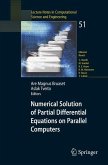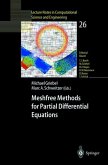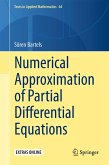The book is suitable for readers with a background in basic finite element and finite difference methods for partial differential equations who wants gentle introductions to advanced topics like parallel computing, multigrid methods, and special methods for systems of PDEs. The goal of all chapters is to *compute* solutions to problems, hence algorithmic and software issues play a central role. All software examples use the Diffpack programming environment, so to take advantage of these examples some experience with Diffpack is required. There are also some chapters covering complete applications, i.e., the way from a model, expressed as systems of PDEs, through discretization methods, algorithms, software design, verification, and computational examples.
This book is about solving partial differential equations (PDEs). Such equa tions are used to model a wide range ofphenomena in virtually all fields ofsci ence and technology. Inthe last decade, the general availability of extremely powerful computers has shifted the focus in computational mathematics from simplified model problems to much more sophisticated models resembling in tricate features of real life. This change challenges our knowledge in computer science and in numerical analysis. The main objective ofthe present book is to teach modern,advanced tech niques for numerical PDE solution. The book also introduces several models arising in fields likefinance, medicine, material technology, and geology. Inor der to read this book, you must have a basic knowledge of partial differential equations and numerical methods for solving such equations. Furthermore, some background in finite element methods is required. You do not need to know Diffpack, although this programming environment is used in examples throughout the text. Basically, this book is about models, methods, and how to implement the methods. For the implementation part it is natural for us to use Diffpack as the programming environment, because making a PDE solver in Diffpack requires little amount of programming and because Diff pack has support for the advanced numerical methods treated in this book. Most chapters have a part on models and methods, and a part on imple mentation and Diffpack programming. The exposition is designed such that readers can focus only on the first part, if desired.
Hinweis: Dieser Artikel kann nur an eine deutsche Lieferadresse ausgeliefert werden.
This book is about solving partial differential equations (PDEs). Such equa tions are used to model a wide range ofphenomena in virtually all fields ofsci ence and technology. Inthe last decade, the general availability of extremely powerful computers has shifted the focus in computational mathematics from simplified model problems to much more sophisticated models resembling in tricate features of real life. This change challenges our knowledge in computer science and in numerical analysis. The main objective ofthe present book is to teach modern,advanced tech niques for numerical PDE solution. The book also introduces several models arising in fields likefinance, medicine, material technology, and geology. Inor der to read this book, you must have a basic knowledge of partial differential equations and numerical methods for solving such equations. Furthermore, some background in finite element methods is required. You do not need to know Diffpack, although this programming environment is used in examples throughout the text. Basically, this book is about models, methods, and how to implement the methods. For the implementation part it is natural for us to use Diffpack as the programming environment, because making a PDE solver in Diffpack requires little amount of programming and because Diff pack has support for the advanced numerical methods treated in this book. Most chapters have a part on models and methods, and a part on imple mentation and Diffpack programming. The exposition is designed such that readers can focus only on the first part, if desired.
Hinweis: Dieser Artikel kann nur an eine deutsche Lieferadresse ausgeliefert werden.








